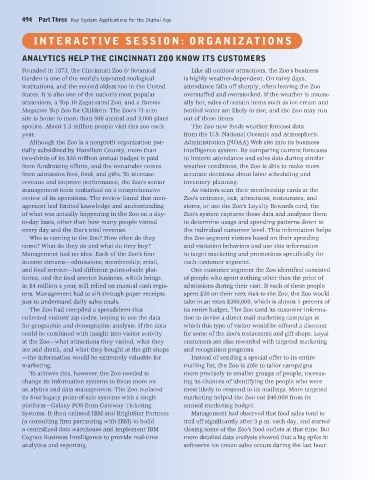Page 495 -
P. 495
494 Part Three Key System Applications for the Digital Age
INTERACTIVE SESSION: ORGANIZATIONS
ANALYTICS HELP THE CINCINNATI ZOO KNOW ITS CUSTOMERS
Founded in 1873, the Cincinnati Zoo & Botanical Like all outdoor attractions, the Zoo’s business
Garden is one of the world’s top-rated zoological is highly weather-dependent. On rainy days,
institutions, and the second oldest zoo in the United attendance falls off sharply, often leaving the Zoo
States. It is also one of the nation’s most popular overstaffed and overstocked. If the weather is unusu-
attractions, a Top 10 Zagat-rated Zoo, and a Parents ally hot, sales of certain items such as ice cream and
Magazine Top Zoo for Children. The Zoo’s 71-acre bottled water are likely to rise, and the Zoo may run
site is home to more than 500 animal and 3,000 plant out of these items.
species. About 1.3 million people visit this zoo each The Zoo now feeds weather forecast data
year. from the U.S. National Oceanic and Atmospheric
Although the Zoo is a nonprofit organization par- Administration (NOAA) Web site into its business
tially subsidized by Hamilton County, more than intelligence system. By comparing current forecasts
two-thirds of its $26 million annual budget is paid to historic attendance and sales data during similar
from fundraising efforts, and the remainder comes weather conditions, the Zoo is able to make more
from admission fees, food, and gifts. To increase accurate decisions about labor scheduling and
revenue and improve performance, the Zoo’s senior inventory planning.
management team embarked on a comprehensive As visitors scan their membership cards at the
review of its operations. The review found that man- Zoo’s entrance, exit, attractions, restaurants, and
agement had limited knowledge and understanding stores, or use the Zoo’s Loyalty Rewards card, the
of what was actually happening in the Zoo on a day- Zoo’s system captures these data and analyzes them
to-day basis, other than how many people visited to determine usage and spending patterns down to
every day and the Zoo’s total revenue. the individual customer level. This information helps
Who is coming to the Zoo? How often do they the Zoo segment visitors based on their spending
come? What do they do and what do they buy? and visitation behaviors and use this information
Management had no idea. Each of the Zoo’s four to target marketing and promotions specifically for
income streams—admissions, membership, retail, each customer segment.
and food service—had different point-of-sale plat- One customer segment the Zoo identified consisted
forms, and the food service business, which brings of people who spent nothing other than the price of
in $4 million a year, still relied on manual cash regis- admissions during their visit. If each of these people
ters. Management had to sift through paper receipts spent $20 on their next visit to the Zoo, the Zoo would
just to understand daily sales totals. take in an extra $260,000, which is almost 1 percent of
The Zoo had compiled a spreadsheet that its entire budget. The Zoo used its customer informa-
collected visitors’ zip codes, hoping to use the data tion to devise a direct mail marketing campaign in
for geographic and demographic analysis. If the data which this type of visitor would be offered a discount
could be combined with insight into visitor activity for some of the Zoo’s restaurants and gift shops. Loyal
at the Zoo—what attractions they visited, what they customers are also rewarded with targeted marketing
ate and drank, and what they bought at the gift shops and recognition programs.
—the information would be extremely valuable for Instead of sending a special offer to its entire
marketing. mailing list, the Zoo is able to tailor campaigns
To achieve this, however, the Zoo needed to more precisely to smaller groups of people, increas-
change its information systems to focus more on ing its chances of identifying the people who were
an alytics and data management. The Zoo replaced most likely to respond to its mailings. More targeted
its four legacy point-of-sale systems with a single marketing helped the Zoo cut $40,000 from its
platform—Galaxy POS from Gateway Ticketing annual marketing budget.
Systems. It then enlisted IBM and BrightStar Partners Management had observed that food sales tend to
(a consulting firm partnering with IBM) to build trail off significantly after 3 p.m. each day, and started
a centralized data warehouse and implement IBM closing some of the Zoo’s food outlets at that time. But
Cognos Business Intelligence to provide real-time more detailed data analysis showed that a big spike in
analytics and reporting. soft-serve ice cream sales occurs during the last hour
MIS_13_Ch_12 global.indd 494 1/17/2013 2:30:30 PM

